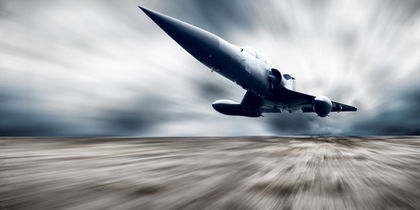AERODYNAMICS

Though the term "aerodynamics" is most commonly associated with airplanes and the overall science of flight, in fact, its application is much broader. Simply put, aerodynamics is the study of airflow and its principles, and applied aerodynamics is the science of improving manmade objects such as airplanes and automobiles in light of those principles. Aside from the obvious application to these heavy forms of transportation, aerodynamic concepts are also reflected in the simplest of manmade flying objects—and in the natural model for all studies of flight, a bird's wings.
All physical objects on Earth are subject to gravity, but gravity is not the only force that tends to keep them pressed to the ground. The air itself, though it is invisible, operates in such a way as to prevent lift, much as a stone dropped into the water will eventually fall to the bottom. In fact, air behaves much like water, though the downward force is not as great due to the fact that air's pressure is much less than that of water. Yet both are media through which bodies travel, and air and water have much more in common with one another than either does with a vacuum.
Liquids such as water and gasses such as air are both subject to the principles of fluid dynamics, a set of laws that govern the motion of liquids and vapors when they come in contact with solid surfaces. In fact, there are few significant differences—for the purposes of the present discussion—between water and air with regard to their behavior in contact with solid surfaces.
When a person gets into a bathtub, the water level rises uniformly in response to the fact that a solid object is taking up space. Similarly, air currents blow over the wings of a flying aircraft in such a way that they meet again more or less simultaneously at the trailing edge of the wing. In both cases, the medium adjusts for the intrusion of a solid object. Hence within the parameters of fluid dynamics, scientists typically use the term "fluid" uniformly, even when describing the movement of air.
The study of fluid dynamics in general, and of air flow in particular, brings with it an entire vocabulary. One of the first concepts of importance is viscosity, the internal friction in a fluid that makes it resistant to flow and resistant to objects flowing through it. As one might suspect, viscosity is a far greater factor with water than with air, the viscosity of which is less than two percent that of water. Nonetheless, near a solid surface—for example, the wing of an airplane—viscosity becomes a factor because air tends to stick to that surface.
Also significant are the related aspects of density and compressibility. At speeds below 220 MPH (354 km/h), the compressibility of air is not a significant factor in aerodynamic design. However, as air flow approaches the speed of sound—660 MPH (1,622 km/h)—compressibility becomes a significant factor. Likewise temperature increases greatly when airflow is supersonic, or faster than the speed of sound.
All objects in the air are subject to two types of airflow, laminar and turbulent. Laminar flow is smooth and regular, always moving at the same speed and in the same direction. This type of airflow is also known as streamlined flow, and under these conditions every particle of fluid that passes a particular point follows a path identical to all particles that passed that point earlier. This may be illustrated by imagining a stream flowing around a twig.
By contrast, in turbulent flow the air is subject to continual changes in speed and direction—as for instance when a stream flows over shoals of rocks. Whereas the mathematical model of laminar airflow is rather straightforward, conditions are much more complex in turbulent flow, which typically occurs in the presence either of obstacles or of high speeds.
Absent the presence of viscosity, and thus in conditions of perfect laminar flow, an object behaves according to Bernoulli's principle, sometimes known as Bernoulli's equation. Named after the Swiss mathematician and physicist Daniel Bernoulli (1700-1782), this proposition goes to the heart of that which makes an airplane fly.
While conducting experiments concerning the conservation of energy in liquids, Bernoulli observed that when the diameter of a pipe is reduced, the water flows faster. This suggested to him that some force must be acting upon the water, a force that he reasoned must arise from differences in pressure. Specifically, the slower-moving fluid had a greater pressure than the portion of the fluid moving through the narrower part of the pipe. As a result, he concluded that pressure and velocity are inversely related.
Bernoulli's principle states that for all changes in movement, the sum of static and dynamic pressure in a fluid remain the same. A fluid at rest exerts static pressure, which is the same as what people commonly mean when they say "pressure," as in "water pressure." As the fluid begins to move, however, a portion of the static pressure—proportional to the speed of the fluid—is converted to what scientists call dynamic pressure, or the pressure of movement. The greater the speed, the greater the dynamic pressure and the less the static pressure. Bernoulli's findings would prove crucial to the design of aircraft in the twentieth century, as engineers learned how to use currents of faster and slower air for keeping an airplane aloft.
Very close to the surface of an object experiencing airflow, however, the presence of viscosity plays havoc with the neat proportions of the Bernoulli's principle. Here the air sticks to the object's surface, slowing the flow of nearby air and creating a "boundary layer" of slow-moving

These and a number of other factors contribute to the coefficients of drag and lift. Simply put, drag is the force that opposes the forward motion of an object in airflow, whereas lift is a force perpendicular to the direction of the wind, which keeps the object aloft. Clearly these concepts can be readily applied to the operation of an airplane, but they also apply in the case of an automobile, as will be shown later.
thanking you
Plz help me..
Thanks a lot.